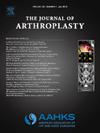Do Intra-articular Metal Ion Levels Predict Adverse Local Tissue Reaction in Revision Total Hip Arthroplasty for Mechanically Assisted Crevice Corrosion?
IF 3.4
2区 医学
Q1 ORTHOPEDICS
引用次数: 0
Abstract
Background
Mechanically assisted crevice corrosion is a complication that may occur in vivo at modular metal interfaces following metal-on-polyethylene total hip arthroplasty (THA). Metal ions released in vivo may be associated with adverse local tissue reactions (ALTRs). While there is no definitive value, high serum ion levels are implicated as contributors to ALTR, and various screening levels have been recommended. The purpose of this investigation was to evaluate the relationship between synovial fluid (SF) cobalt and chromium ion levels and the risk of developing ALTR.
Methods
This was a retrospective cohort study of 552 patients who underwent 621 metal-on-polyethylene primary THAs. A total of 69 patients underwent revision THA due to symptomatic primary failure with elevated serum metal ions levels. There were 28 who had preoperative serum and intraoperative SF chromium and cobalt samples. Patient demographics, surgical, and laboratory data were collected. Descriptive statistics, Mann-Whitney U, analysis of variance tests, and linear regression analyses were performed.
Results
There were 40.6% of revisions that had preoperative serum and intraoperative SF samples. The mean time to revision was 5.7 (range, 3.8 to 7.6) years. Mean SF cobalt and chromium levels were 870.9mcg/L (range, 1.1 to 8,300.0) and 573.5mcg/L (range, 1.3 to 10,000.0). Mean serum and SF cobalt-chromium ratios were 4.0 (range, 0.9 to 7.1) and 6.4 (range, 0 to 15.1), respectively. Elevated serum cobalt levels were predictive of ALTR (P = 0.002), SF levels were not. Analysis of preoperative serum to SF cobalt-chromium ratios showed poor correlation (R2 = 0.05).
Conclusions
There was no correlation between SF ion levels and ALTR. Also, serum and intra-articular ion levels did not correlate. The SF levels did not provide additional value over serum levels for diagnosis or prognosis of mechanically assisted crevice corrosion. Further studies are needed to better understand the relationship between serum and SF ion levels and its relationship to ALTR.
关节内金属离子水平能否预测翻修全髋关节置换术中因机械辅助缝隙腐蚀引起的局部组织不良反应?
背景:机械辅助缝隙腐蚀(MACC)是聚乙烯上金属(MoP)全髋关节置换术(THA)后模块金属界面可能出现的一种并发症。体内释放的金属离子可能与局部组织不良反应(ALTR)有关。虽然没有明确的数值,但高血清离子水平被认为是 ALTR 的诱因,并推荐了不同的筛查水平。本研究旨在评估滑膜液(SF)中钴和铬离子水平与发生 ALTR 风险之间的关系:这是一项回顾性队列研究,对接受了 621 次 MoP 初级 THAs 的 552 名患者进行了研究。共有 69 名患者因血清金属离子水平升高的无症状原发性失败而接受了翻修 THA。其中 28 名患者在术前采集了血清样本,术中采集了 SF 铬和钴样本。收集了患者的人口统计学、手术和实验室数据。进行了描述性统计、Mann-Whitney U、方差分析(ANOVA)测试和线性回归分析:结果:40.6%的翻修患者在术前采集了血清样本和术中采集了 SF 样本。平均翻修时间为 5.7 年(范围为 3.8 至 7.6 年)。平均 SF 钴和铬水平分别为 870.9 毫微克/升(范围在 1.1 至 8,300.0 之间)和 573.5 毫微克/升(范围在 1.3 至 10,000.0 之间)。平均血清和 SF 钴铬比分别为 4.0(范围为 0.9 至 7.1)和 6.4(范围为 0 至 15.1)。血清钴水平升高可预测 ALTR(P = 0.002),而 SF 水平则不能。对术前血清与 SF 钴铬比值的分析显示相关性较差(R2 = 0.05):结论:SF离子水平与ALTR之间没有相关性。结论:SF离子水平与ALTR之间没有相关性,血清离子水平与关节内离子水平也没有相关性,SF水平对澳门巴黎人娱乐官网的诊断或预后没有比血清水平更高的价值。要更好地了解血清和 SF 离子水平之间的关系及其与 ALTR 的关系,还需要进一步的研究。
本文章由计算机程序翻译,如有差异,请以英文原文为准。
求助全文
约1分钟内获得全文
求助全文
来源期刊

Journal of Arthroplasty
医学-整形外科
CiteScore
7.00
自引率
20.00%
发文量
734
审稿时长
48 days
期刊介绍:
The Journal of Arthroplasty brings together the clinical and scientific foundations for joint replacement. This peer-reviewed journal publishes original research and manuscripts of the highest quality from all areas relating to joint replacement or the treatment of its complications, including those dealing with clinical series and experience, prosthetic design, biomechanics, biomaterials, metallurgy, biologic response to arthroplasty materials in vivo and in vitro.
 求助内容:
求助内容: 应助结果提醒方式:
应助结果提醒方式:


